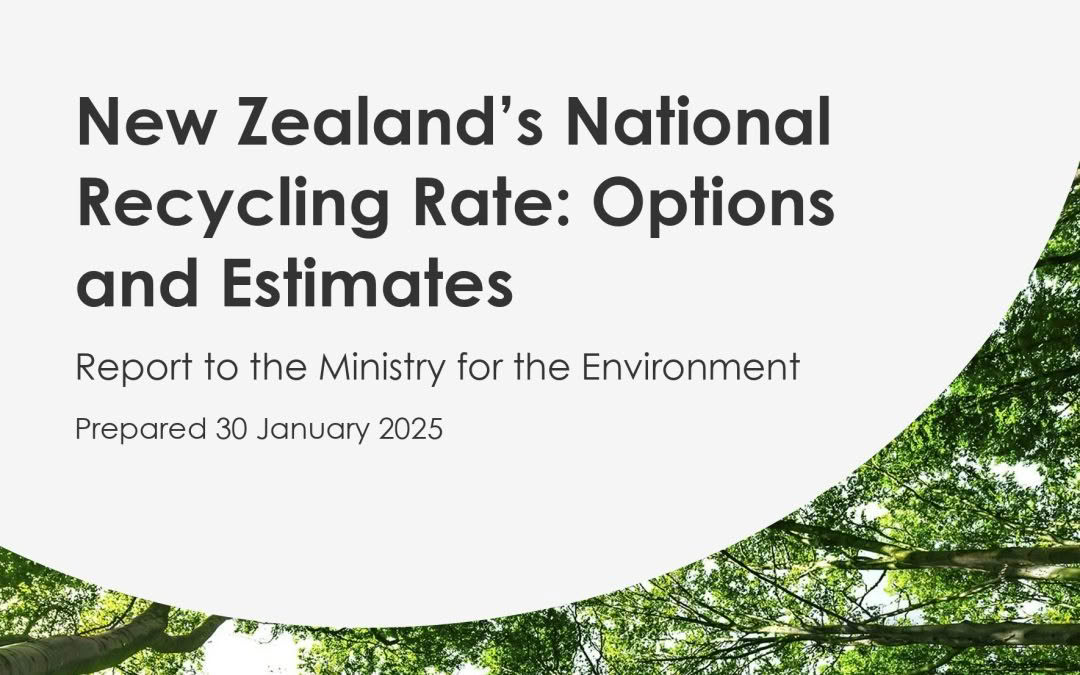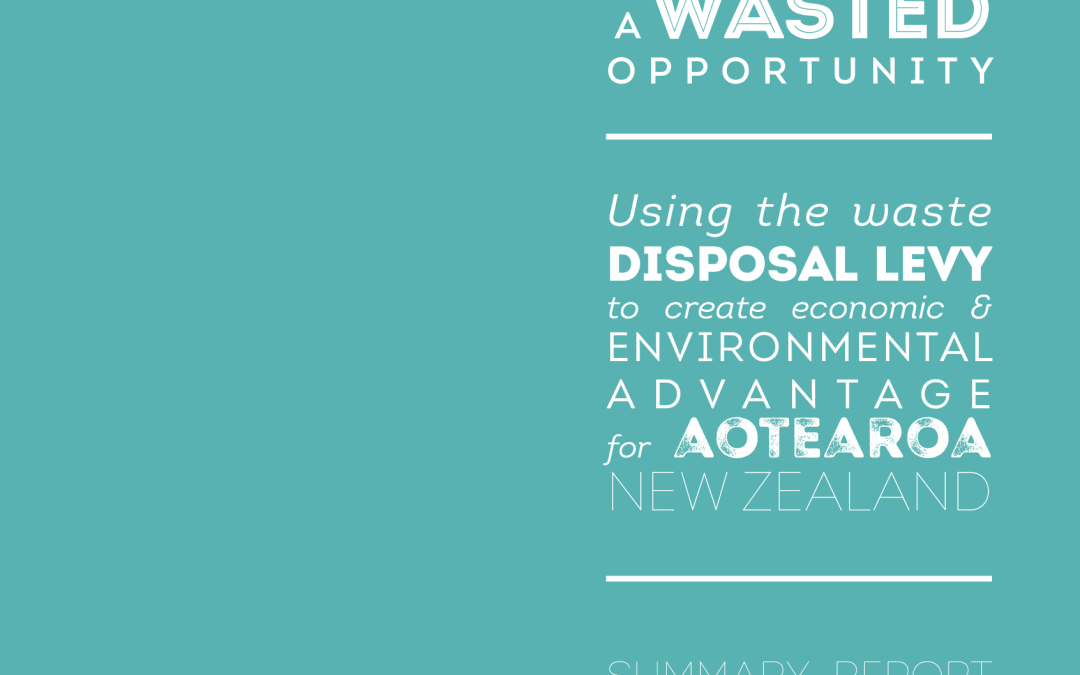
by Duncan Wilson | 4 Apr 2025 | article, Policy, Policy & Strategy, Reports, Waste, Waste & Recycling
The Ministry for the Environment commissioned Eunomia to produce a report about recycling rates that would assist them to determine how to calculate national recycling rates for Aotearoa New Zealand. Six metrics were put forward for the Ministry’s refinement and future use, including sets that are comparable to existing Australian, OECD, and EU metrics.
Typically national waste metrics include recycling rates presented as percentages of waste recovered compared to total waste generated, and per capita metrics for total waste generated presented as kilograms of municipal waste per person per annum. Although these calculations appear to be straightforward there are many variables including waste streams, activity sources, and destination types that could be included or excluded from the definition of municipal waste and therefore the calculation of the recycling rate. It is also important to consider what information is available and what may need to be estimated.
The report begins with a review of metrics from jurisdictions within Australia, European Union, United Kingdom, United States, as well as for the OECD and PacWaste Plus programme to analyse existing approaches and determine useful methods or lessons that could be adopted or adapted for New Zealand. The international review found that the data obtained appears to be incomplete or inconsistent, relying on significant data manipulation and estimates. Although all jurisdictions reported on “municipal solid waste”, the definition and scope varies between them. The report also reflected that this metric overlooks non-municipal waste streams that generate a significant amount of waste (e.g. construction and demolition and industrial waste) that could have a greater potential for diversion and/or reduction.
Next, the report reviewed the availability and quality of datasets from government, research, industry, and product stewardship sources that could be called upon to generate national recycling rate metrics. The analysis found that data should be improved overtime for accurate recycling rate metric calculations, and that there is a lack of on-going data for material recovery.
The report brings together learnings from the international metrics review and the national dataset review to explore metrics that could be used in New Zealand. This involved generating a dataset of the best available data to use alongside a recycling rate model to calculate metrics. The six rates that were generated for the report differed by what material streams and/or facilities were included, in order to produce metrics that were comparable to existing Australian, OECD, and EU metrics.

by Duncan Wilson | 28 Nov 2019 | Disposal, News, Policy, Policy & Strategy, Recycling, Waste, Waste & Recycling
The Government has announced a consultation on changes to the waste disposal levy. The proposals would see the rate of the levy increase to $50-$60 a tonne by 2023 for waste to class 1 landfills. The levy would also be extended to cover classes 2-4 landfills at lower rates of $10-$20 a tonne. Eunomia NZ Director Duncan Wilson was interviewed on Radio NZ’s nine to noon programme about the Governments proposed changes to the waste disposal levy.
https://www.rnz.co.nz/national/programmes/ninetonoon/audio/2018724472/national-landfill-levy-how-much-should-we-be-paying
by Duncan Wilson | 22 Jan 2018 | Councils, News, Policy, Recent, Recycling, Strategy, Waste
Eunomia worked with the WasteMINZ TA Forum to update the Local Government Waste Manifesto that we originally helped create in 2018. Since the first Manifesto was produced there have been a range of significant changes in the sector. These include the impacts of China’s ‘National Sword’ policy, the ongoing impacts of Covid 19 and the global economic recession, and a growing awareness around the need to tackle plastic pollution.
The updated Manifesto was released on 4 August 2020. It sets out a number of additional actions for Government that will enable real reductions in waste to landfill and reduce the costs borne by councils and their communities. Together with the original 5 actions, the key elements are:
- Review the New Zealand Waste Strategy to set a clear programme for action
- Expand the Waste Disposal Levy and progressively raise the levy to reduce waste to landfill
- Officially adopt the National Waste Data Framework to enable better planning and monitoring
- Introduce a Container Deposit Scheme to lift recycling rates and reduce litter and marine pollution
- Implement mandatory or co-designed product stewardship schemes for tyres, e-waste and, agrichemicals, and farm plastics
- Invest in onshore and local infrastructure for processing recovered materials
- Standardise household rubbish and recycling collection systems
- Take action on plastics and packaging to reduce pollution and make sure all packaging used or made in NZ can be re-used or recycled
To download a copy of the updated Manifesto click the download button below:
Download
To download a copy of the orignial Manifesto click the download button below:
Download
by Duncan Wilson | 2 Aug 2017 | article, News, Policy, Recent, Reports, Waste
Duncan Wilson is featured in the August issue of Local Government magazine, talking about the recent Eunomia report on New Zealand’s waste levy. Click the button below to download a copy of the article.
Download
by Duncan Wilson | 23 Jul 2017 | News, Policy, Recent, Uncategorized, Waste
Our waste levy research report has generated a lot of interest. Here are some links to media articles:
http://www.radionz.co.nz/national/programmes/ninetonoon/audio/201849672/take-make-dispose-calls-for-landfill-levy-hike
http://www.stuff.co.nz/dominion-post/news/national/94816836/Reluctance-to-charge-more-people-dumping-fees-blamed-for-rise-in-landfill-waste
http://wellington.govt.nz/your-council/news/2017/07/waste-levy
http://www.scoop.co.nz/stories/PO1707/S00018/waste-disposal-levy-could-create-9000-jobs.htm
https://m.newsie.co.nz/news/42399-higher-levy-would-cut-waste-and-create-work.html
http://www.recyclingwasteworld.co.uk/news/new-zealand-could-increase-its-gva-by-287m-by-restructuring-its-waste-disposal-levy-says-eunomia-report/157045/
http://www.recyclingwasteworld.co.uk/news/new-zealand-could-increase-its-gva-by-287m-by-restructuring-its-waste-disposal-levy-says-eunomia-report/157045/
http://www.nzherald.co.nz/wanganui-chronicle/midweek/news/article.cfm?c_id=1503658&objectid=11885818
https://t.co/WsgHHqrwWP
https://twitter.com/hashtag/NZWasteLevy?src=hash
by Duncan Wilson | 2 Jul 2017 | News, Organic, Policy, Recent, Recycling, Reports, Strategy, Sustainability, Waste
Eunomia Research & Consulting undertook research to improve understanding of the impacts of possible changes to the structure and rate of the Waste Disposal Levy.
The study, which was commissioned by a consortium of businesses and councils, showed that there are likely to be real benefits for NZ through putting in place a well-structured levy regime. The research found there would be significant benefits in terms of waste minimisation, employment, and the economy. Key features should include:
- Extending the levy to all types of fills
- A large increase in the rate of the levy
- A differential between ‘active’ waste and ‘inert’ waste
- An escalation to the target rates over time
- Increased monitoring and enforcement, and
- Targeted spending of levy income.
Download the summary report
Download
Download the full report
Download
by Duncan Wilson | 5 Jun 2017 | Marine, Policy, Reports, Sustainability, Waste
This report, from Eunomia UK, highlights the potential for a measures-based approach to be more effective at tackling marine plastic litter than setting targets.
Marine plastics are an emerging issue facing policy makers. However, the information we currently have on the impacts of marine plastics is limited. This makes it challenging to identify what a ‘socially optimal’ level of marine plastic pollution would be. The lack of information seems to be encouraging a wide spectrum of policy responses, which range from a complete ban on many kinds of plastic at one extreme, to “do nothing until we’ve improved our data” at the other.
This document reflects upon the data challenge and explains why detailed monitoring of marine litter is difficult, expensive and ultimately, perhaps, unnecessary. It argues that setting reduction targets for marine plastics is unlikely to be effective policy. Instead, it proposes a “Best Available Technique” approach to the selection of measures, similar to the way in which industrial emissions are addressed.
This report is available free of charge. Press the button below to download.
download

